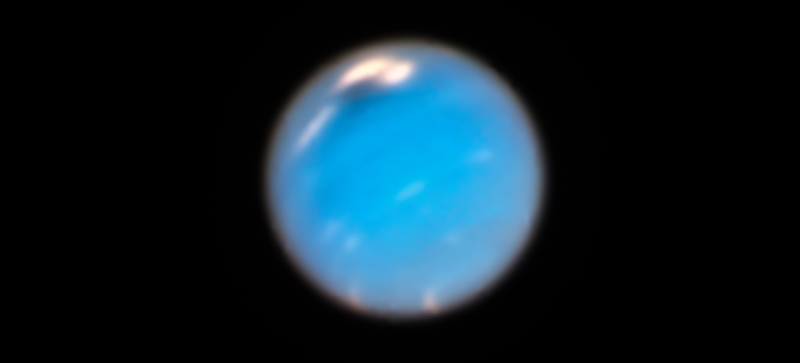[MENTION=73]tinfoilhat[/MENTION]
https://gizmodo.com/whoa-uranus-looks-totally-messed-up-right-now-1832461611


https://gizmodo.com/whoa-uranus-looks-totally-messed-up-right-now-1832461611

The appearance of a massive white cap on Uranus may seem alarming, but as planetary scientists are learning, this is what a prolonged summer looks like on the remote ice giant.
Ice giants Uranus and Neptune have water-rich interiors coated with hydrogen, helium, and a pinch of methane, the latter of which gives these outer planets their distinctive cyan complexion. Unlike Earth, where seasons last just a few months, Neptune and Uranus experience seasons that last for decades, resulting in strange and intense atmospheric phenomena.
New images released by the Outer Planet Atmospheres Legacy (OPAL) program highlight a evolving atmospheric events on both ice giants, namely an extended white cap over Uranus’ north pole and a new dark vortex on Neptune. A long-term side project of the Hubble program, OPAL is an annual effort to map these two planets when their orbital paths bring them closest to Earth. The new data, captured during the autumn of 2018, are providing important new insights into the seasonal variations on both Neptune and Uranus.
“The yearly observations are helping us to understand the frequency of storms, as well as their longevity,” Amy Simon, a scientist at NASA’s Goddard Space Flight Center who leads the OPAL mission, told Gizmodo. “That’s important because these planets are quite far from the Sun, so this will help constrain how they are forming and more about the internal heat and structure of these planets. Most of the extrasolar planets that have been found are this size of planet, though at all sorts of distances from their parent stars.”
The large white cap strewn over the north pole of Uranus is particularly dramatic. The likely cause of this feature has to do with the planet’s unique tilt, which causes sunlight to shine directly onto the north polar regions for an extended period of time during the summer. It’s currently mid-summer at Uranus’ north pole, resulting in the protracted white cap.
“The November 2018 image of Uranus occurs at a time 10 years after the equinox, when the northern hemisphere was just emerging into spring sunlight after spending decades in polar winter,” Leigh Fletcher, an astronomer at the University of Leicester, told Gizmodo. “Back in 2007, there didn’t appear to be anything like this polar cap over the springtime pole. But as time progressed, a reflective band—whitish against Uranus’ blue hues—began to appear encircling the north pole. And now, 10 years on, that band has turned into a thick polar cap of aerosols that’s hiding the deeper polar region from view.”
Fletcher said it’s a “spectacular example of seasonal change” on this ice giant, with “the aerosol cap evolving as spring becomes summer.” The exact causes of these aerosol changes, he said, remain a mystery, with possibilities including warming temperatures, unusual chemistry, some large-scale atmospheric circulation pattern, or a combination of all these.
“Thankfully we’re not too far away from having an answer, as the James Webb Space Telescope will be able to diagnose the temperatures and chemistry responsible for these reflectivity changes that Hubble has been monitoring,” added Fletcher.
Patrick Irwin, a planetary scientist at Oxford University, said the phenomenon is not a storm, as NASA described it in its release. Rather, “it’s caused mainly—at least in our models—by a lowering of the methane abundance above the main cloud deck accompanied by a possible slight increase in the haze opacity,” he told Gizmodo.
Simon thought the expanded Uranian polar feature was cool, but “more interesting to me is that bright storm just below it,” she told Gizmodo. “That particular storm had flared up and was visible in small ground-based telescopes just prior to these observations, which shows how quickly they can change.”

Looking at the new Neptune image, it appears that a dark vortex has once again reared its ugly—yet fascinating—head. The new anti-cyclonic storm, seen at the top center of the photo above, is about 11,000 kilometers (6,800 miles) across. This is now the fourth dark vortex observed by Hubble since 1993. Two of these storms were observed by the Voyager 2 probe during its flyby of the system in 1989. Taken together, these observations affirm the transient and recurring nature of these storms. A polar vortex observed in 2016, for example, has largely faded away.
“The Neptune dark spot is much larger than the one we saw a few years ago, and is comparable in size to the Voyager Great Dark Spot seen in 1989,” said Simon. “This is also the first time we could see the region before a storm of that size formed, so that will help us in modeling the formation process.”
The causes of these dark spots is a mystery, but because they’re only seen at the bluest wavelengths, “my money is on some sort of coloration of the clouds,” said Irwin.
Often overshadowed by their larger cousins, Jupiter and Saturn, these distant ice giants are proving to be fascinating in their own right. We now await next year’s OPAL observations with much anticipation.


